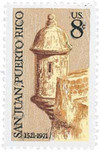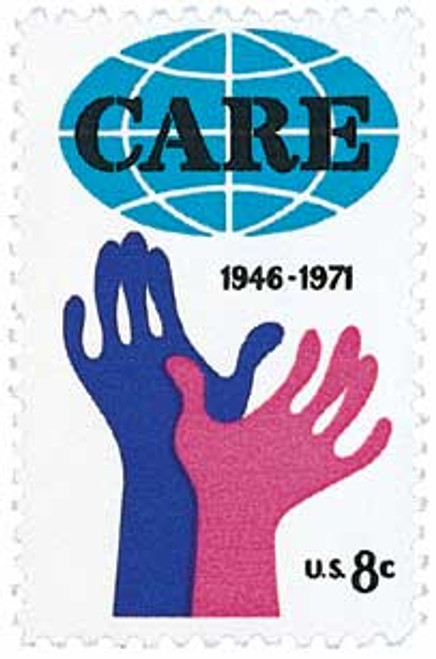
# 1437a - 1971 8c San Juan
U.S. #1437a Tagging Omitted
8¢ San Juan
Issue Date: September 12, 1971
City: San Juan, Puerto Rico
Printed By: Bureau of Engraving and Printing
Printing Method: Lithographed, engraved
Perforations: 11
Color: Pale brown, black, yellow and dark brown
This stamp commemorates the 450th anniversary of San Juan, Puerto Rico – the oldest continuously inhabited city in America. The stamp design is based on a woodcut.
In 1508, Spanish Explorer Juan Ponce de León established the settlement of Caparra on the south shore of San Juan Bay. A year later, the Caparra settlement was moved to a small island on the north side of the bay and renamed Puerto Rico. Its name was changed to San Juan in 1521, with the entire island taking on the name of Puerto Rico. Due to its prominence on the trade routes, a series of fortifications was built to defend the settlement. Known generally as “El Morro,” the fort withstood attacks by British, French, and Dutch raiders, as well as numerous pirate attacks. The fort still stands today.
Now you can own this stamp with rare tagging omitted. Did you know a stamp missing its phosphorescent tagging is considered by many to be similar to a missing color error? The good news is that unlike some error stamps, untagged error stamps are affordable.
What is Phosphorescent Tagging and Why is it Important?
Tagging of U.S. stamps was introduced in 1963 with airmail stamp #C64a. It helps the U.S. Post Office use automation to move the mail at a lower cost. A virtually invisible phosphorescent material is applied either to stamp ink or paper, or to stamps after printing. This “taggant” causes each one to glow in shades of green (red on older airmails) for a moment after exposure to short-wave ultraviolet (UV) light. The afterglow makes it possible for facing-canceling machines to locate the stamp on the mail piece, and properly position it for automated cancellation and sorting.
Some stamps have been printed with and without tagging intentionally, but when tagging is omitted by accident, we collectors are treated to a scarce modern color error. Our stamp experts examined thousands of stamps to find these just for you. Now you can easily give your error collection a boost or explore this fascinating new area of collecting. Quantities are limited, so order your untagged error stamp right away.
And find more tagging omitted stamps here.
U.S. #1437a Tagging Omitted
8¢ San Juan
Issue Date: September 12, 1971
City: San Juan, Puerto Rico
Printed By: Bureau of Engraving and Printing
Printing Method: Lithographed, engraved
Perforations: 11
Color: Pale brown, black, yellow and dark brown
This stamp commemorates the 450th anniversary of San Juan, Puerto Rico – the oldest continuously inhabited city in America. The stamp design is based on a woodcut.
In 1508, Spanish Explorer Juan Ponce de León established the settlement of Caparra on the south shore of San Juan Bay. A year later, the Caparra settlement was moved to a small island on the north side of the bay and renamed Puerto Rico. Its name was changed to San Juan in 1521, with the entire island taking on the name of Puerto Rico. Due to its prominence on the trade routes, a series of fortifications was built to defend the settlement. Known generally as “El Morro,” the fort withstood attacks by British, French, and Dutch raiders, as well as numerous pirate attacks. The fort still stands today.
Now you can own this stamp with rare tagging omitted. Did you know a stamp missing its phosphorescent tagging is considered by many to be similar to a missing color error? The good news is that unlike some error stamps, untagged error stamps are affordable.
What is Phosphorescent Tagging and Why is it Important?
Tagging of U.S. stamps was introduced in 1963 with airmail stamp #C64a. It helps the U.S. Post Office use automation to move the mail at a lower cost. A virtually invisible phosphorescent material is applied either to stamp ink or paper, or to stamps after printing. This “taggant” causes each one to glow in shades of green (red on older airmails) for a moment after exposure to short-wave ultraviolet (UV) light. The afterglow makes it possible for facing-canceling machines to locate the stamp on the mail piece, and properly position it for automated cancellation and sorting.
Some stamps have been printed with and without tagging intentionally, but when tagging is omitted by accident, we collectors are treated to a scarce modern color error. Our stamp experts examined thousands of stamps to find these just for you. Now you can easily give your error collection a boost or explore this fascinating new area of collecting. Quantities are limited, so order your untagged error stamp right away.
And find more tagging omitted stamps here.











